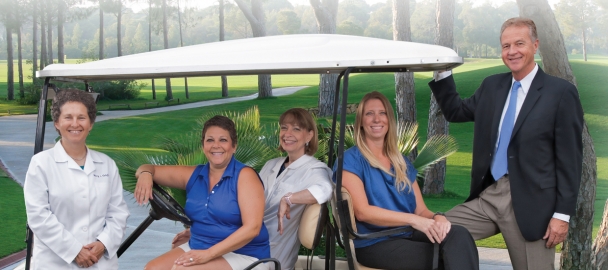
A Winning Course For Kim
No lump in her breast. No family history of cancer. No problems with previous annual mammograms. To most, that would mean peace of mind.
That’s what 49-year-old Kim O’Donoghue thought before her annual check-up at the MemorialCare Breast Center at Saddleback Medical Center. All of that changed when a “suspicious spot” was detected and a pair of doctor-recommended biopsies confirmed the unthinkable: breast cancer.
“Never in a million years did I think I would be diagnosed with cancer,” says Kim, an avid golfer and mother of two.
An Early Catch
The discovery of Kim’s Stage 1 invasive lobular carcinoma was confirmed following a breast MRI as well as an earlier ultrasound procedure that showed abnormalities. Fortunately, with Saddleback Medical Center’s comprehensive approach to diagnostics, Kim’s cancer was caught at an early stage.
“Early detection can dramatically affect treatment options and outcomes. The biology of breast cancer suggests that tumors are often present in the breast, years in advance of diagnosis,” says oncologist Merry Tetef, MD, assistant chair of the cancer committee at Saddleback Medical Center, as well as associate professor at UCLA Medical Center. “Kim and thousands of other women who could not see or feel a lump have beaten breast cancer thanks to detection with an annual screening mammogram.”
Because nearly 95 percent of breast cancers occur in women over age 40, most experts advise women in this age group to begin having annual mammograms. For women who have a strong family history of breast cancer or other risk factors, additional screening exams are recommended.
“State-of-the-art technologies utilized at the Breast Center help physicians see the breast tissue from numerous angles,” adds breast surgeon Michele Carpenter, MD. “These screenings can find cancers when they are about the size of a pea and before they spread. In these earlier stages, there is a high rate of cure.”
A Coordinated Response
It’s what happens after cancer is diagnosed that matters most. At Saddleback Medical Center, specialists work collaboratively to design treatment protocols based on a patient’s individual needs. The hub for that interaction occurs at weekly treatment planning conferences where all specialists, including the oncologists, radiation oncologists, surgeons, breast radiologists, a genetic counselor and a nurse navigator, come together.
“Finding out I had breast cancer was devastating. But my care team at Saddleback Medical Center took care of everything I needed to wage my personal battle against the disease. I felt as though I had 50 people holding my hand,” says Kim.
Back on the Fairway
Kim ultimately underwent successful surgery and other treatments she needed to meet her diagnosis head on. Today, she celebrates being cancer-free.
“Now that I’m feeling better, I’m back out on the golf course, spending time with my family and just doing the things I love again. I cherish these moments and, in my heart, I know I have the team at Saddleback Medical Center to thank. They saved my life,” says Kim.